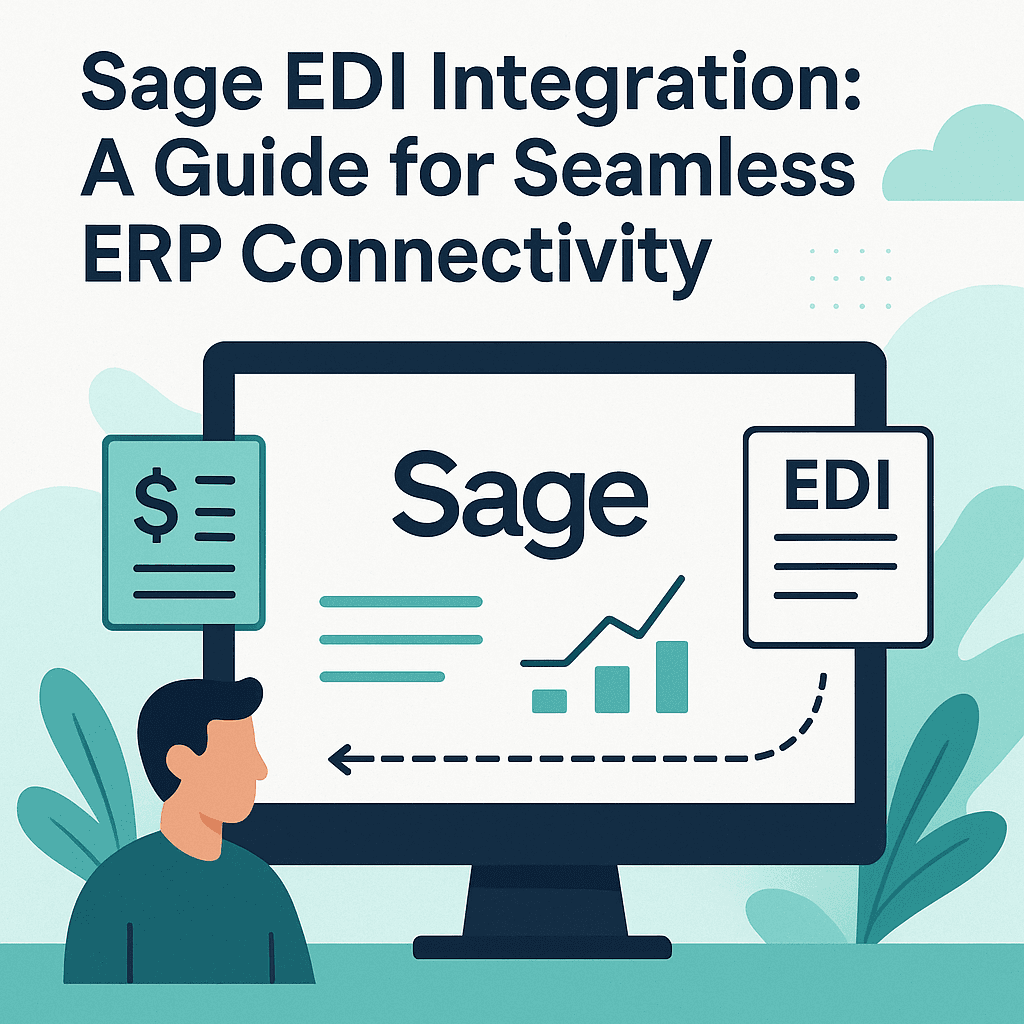Integrate EDI into your Sage ERP with speed and simplicity. Learn when to implement, what to avoid, and how to scale smarter with modern solutions.
Sage ERP platforms are powerful tools for managing finances, inventory, and operations. But in high-volume B2B environments, ERP alone isn’t enough to meet growing demand from retail, logistics, and manufacturing partners. Sage users often need to integrate electronic data interchange (EDI) into their workflows, often adding complexity to their technology stack.
Whether you’re rolling out Sage ERP for the first time, migrating from Sage 100 to X3 or Intacct, or still relying on an older third-party solution, timing and technology matter. Outdated EDI systems can increase the need for manual data entry, lead to delays, and introduce costly mistakes.
This guide breaks down when and how to integrate EDI with Sage, what modern solutions look like, and how to avoid common obstacles. With the right setup, Sage and EDI can work together to improve accuracy, accelerate transactions, and make partner onboarding more efficient.
Why EDI Matters for Sage ERP Users
For organizations that rely on Sage ERP, adding EDI is essential for scaling operations and keeping up with supply chain demands. EDI enables fast, structured communication between systems, helping Sage users automate key business documents, such as purchase orders, invoices, advance shipping notices (ASNs), and inventory updates.
EDI strengthens your Sage ERP environment in several ways, including:
Automating core documents across your supply chain, including orders, ASNs, and invoices, through structured electronic workflows and automation triggers.
Reducing manual data entry and improving data accuracy by enabling system-to-system communication without rekeying.
Supporting compliance with retailers, 3PLs, and distributors by standardizing document formats and ensuring timely delivery.
Improves operational efficiency through faster, cleaner workflows.
Boosts customer satisfaction by ensuring smooth communication.
Without EDI, many Sage users have to rely on manual processes that introduce delays and human errors. This can slow down order fulfillment, trigger costly chargebacks, or make it harder to meet trading partner requirements.
When to Integrate EDI With Sage ERP
The best time to integrate EDI depends on your stage in the Sage ERP lifecycle. Whether you’re implementing Sage for the first time or upgrading to a newer version, aligning your EDI strategy early can help you avoid delays, manual processes, and rework. Our Guide to a Successful ERP Migration provides many additional tips and tricks to help with your integration efforts.
During Initial ERP Setup
Integrating EDI during your initial Sage ERP deployment is often the cleanest, most efficient approach. It allows you to build automated workflows into your system architecture from day one, avoiding the need to add on potentially fragile tools and systems later.
During a Version Upgrade
ERP upgrades are a natural opportunity to modernize your EDI setup. As companies move to more scalable Sage solutions like X3 or Intacct, many discover that older EDI systems don’t keep up. Upgrading both platforms in parallel ensures compatibility, improves long-term performance, and reduces migration risk.
After ERP Is Live
If your ERP is already live, it’s not too late. Many Sage users outgrow their initial EDI solutions, especially if they’re using manual workarounds, brittle middleware, or rigid VAN-based systems. A cloud-native EDI platform like Orderful can connect directly to your existing Sage environment without disrupting operations.
Modern vs. Legacy EDI Integration for Sage
Not all Sage EDI integration solutions are created equal. Legacy platforms often rely on custom scripts, brittle file transfers, and manual onboarding processes that create friction across your operations. In contrast, modern cloud-native platforms are built for speed, scalability, and seamless Sage connectivity, simplifying your ERP integration.
The chart below outlines the key differences between integrating a legacy EDI platform and a modern, cloud-based or web EDI system.
Feature | Legacy EDI Integration | Cloud-Native EDI Integration |
Setup Time | Weeks or months | Days |
Visibility | Limited or delayed | Real-time dashboards |
Partner Onboarding | Manual mapping per partner | Prebuilt trading partner templates |
ERP Compatibility | Custom connectors | Native Sage ERP support (API, file-based, or hybrid) |
Modern EDI providers simplify data interchange by supporting multiple formats, such as CSV, XML, and JSON. Most also offer plug-and-play integrations with Sage 100, Sage 300, X3, and Intacct, as well as self-service tools for partner monitoring, validation, and alerting.
What to Look for in a Sage-Compatible EDI Provider
Choosing the right EDI provider can make or break your Sage ERP integration. While legacy systems may offer basic document exchange, they often fall short in flexibility, speed, and long-term scalability. A modern provider should do more than just connect business systems. They should actively support your growth, align with your business processes, and simplify the partner onboarding process.
Look for these key features for your Sage-compatible EDI solution:
Built-in support for Sage 100, Sage 300, X3, and Intacct to ensure compatibility across versions and workflows.
Transparent, flat-fee pricing, so you’re not penalized for transaction volume or new trading partners.
No-code onboarding tools, empowering even users who are less tech-savvy to configure partner connections quickly.
Self-service dashboards and alerting, so your team can track document flow, resolve errors, and stay informed.
Dedicated onboarding and support teams to guide your implementation and troubleshoot issues quickly.
Realistic Scenario: EDI During a Sage Migration
Say a mid-sized distributor is moving from Sage 100 to Sage X3 to support growth across multiple warehouses. Their existing EDI setup is a patchwork of legacy middleware and manual workflows, which form a bottleneck and cause delays, chargebacks, and duplicate data entry across teams.
Instead of carrying those problems into the new ERP environment, they implement a cloud-native EDI platform like Orderful in parallel with their Sage migration. Prebuilt connections allow them to onboard core trading partners in days, not weeks. Their ops team receives real-time visibility into transaction status through self-service dashboards, which also instantly flag document errors for correction. Built-in validation tools allow them to test and verify the integrity of EDI documents and confirm successful data exchange.
By going live with both systems at once, the distributor avoids rework, reduces onboarding time, and improves fulfillment speed while maintaining data integrity across both systems.
Powering Your ERP With Seamless EDI
Sage ERP users can’t afford to treat EDI as an afterthought. Whether you’re deploying a new ERP, upgrading from Sage 100, or replacing a brittle legacy setup, the right EDI integration can eliminate friction across your fulfillment process, improve accuracy, and create a competitive advantage.
Orderful is a modern EDI platform that simplifies connectivity with Sage 100, Sage 300, X3, and Intacct without middleware or months of setup. With faster partner onboarding, real-time data visibility, and fewer manual touchpoints, your ERP becomes a central hub for smooth, scalable communication.
If your current EDI system is slowing you down or complicating your migration, it may be time for a change. Talk to an EDI expert today and see how Orderful helps Sage users simplify processes and scale with confidence.
Frequently Asked Questions
Does Sage ERP support EDI natively?
No, Sage ERP products like Sage 100, 300, X3, and Intacct do not offer native EDI functionality. Businesses typically rely on external EDI integration solutions to support electronic data interchange.
What’s the easiest way to add EDI to Sage?
The easiest way to integrate EDI with Sage ERP is through a modern cloud-based EDI platform that offers prebuilt connectors, no-code onboarding, and API or file-based support for Sage.
How long does Sage EDI integration take?
With on-premise systems, EDI integration can take weeks or months as teams install add-ons and manually configure partner mappings. With a modern provider, Sage EDI integration often takes just days. Cloud-native platforms offer prebuilt connections and automation tools that dramatically reduce setup time and complexity.
Can I switch EDI providers without touching my ERP?
Yes. Many modern EDI platforms can connect to your existing Sage environment without requiring changes to your ERP configuration. This allows you to replace outdated or expensive EDI providers with minimal disruption.
What are the risks of waiting too long to implement EDI?
Delaying EDI integration can lead to fulfillment delays, manual data entry errors, missed partner requirements, and costly chargebacks. Most modern high-volume supply chain partners require their business partners to use EDI because it can support a large number of order and shipment requests relatively quickly. Retailers who rely on older systems miss out on the benefits of a faster, more reliable EDI system.

